Help for business
JobKeeper 2.0
The Government has announced further changes to the JobKeeper scheme. The good news is that employees that missed out on JobKeeper because they were not employed on 1 March 2020 might now be eligible. The proposed changes would enable employees employed on 1 July 2020 to receive JobKeeper payments from 3 August if they meet the other eligibility criteria. If you have employees impacted by this change, you will still need to work through the eligibility requirements including providing JobKeeper Payment Employee Nomination, but just remember that these changes are not yet law.
JobKeeper will also be extended beyond 27 September 2020. To receive JobKeeper from 28 September 2020, employers will need to reassess their eligibility with reference to actual GST turnover for the September 2020 quarter (for JobKeeper payments between 28 September to 3 January 2021), and again for the December 2020 quarter (for payments between 4 January 2021 to 28 March 2021).
Most businesses will generally use their Business Activity Statement (BAS) reporting to assess eligibility. However, as the BAS is generally not due until the month after the end of the quarter, eligibility for JobKeeper will need to be assessed in advance of the BAS reporting deadlines to meet the wage condition for eligible employees.
However, the ATO will have the discretion to extend the time an entity has to pay employees in order to meet the wage condition.
From 28 September 2020, the payment rates for JobKeeper will reduce and split into a higher and lower rate. Whether an eligible employee can access the higher or lower rate will depend on the number of hours they worked during a 4-week test period. The higher rate will apply to employees who worked at least 20 hours a week on average in the four weeks of pay periods prior to either 1 March 2020 or 1 July 2020. Between 28 September 2020 and 3 January 2021, the higher rate is $1,200 per fortnight and $750 for the lower rate. Between 4 January and 28 March 2021, the higher rate is $1,000 per fortnight and $650 for the lower rate.
| JobKeeper payment rate | 30 Mar to 27 Sept 2020 | 28 Sept to 3 Jan 2021 | 4 Jan 2021 to 28 Mar 2021 |
| < 20 hours | $1,500 | $1,200 | $1,000 |
| > 20 hours | $1,500 | $750 | $650 |
Cashflow boost payments
If your business received the first cashflow boost tranche, you will receive a further cash flow boost for the June to September quarters of the same amount. If you report quarterly, the cashflow boost will be paid in two equal payments for June and September. If you report monthly, the cashflow boost is provided in four equal payments.
The cashflow boost is applied to reduce any liabilities in the same reporting period with any excess amount being paid as a cash refund from the ATO.
Support for business employing apprentices and trainees
JobTrainer provides a 50% reimbursement to eligible employers for the cost of apprentice or trainee wages up to $7,000 per quarter. Originally only for small businesses employing less than 20 employees, the subsidy recently expanded to include businesses with under 200 employees.
For small businesses (under 20 employees), the apprentice had to be employed on 1 March 2020 or on 1 July 2020 for claims after this date (claims are open now). For medium sized businesses (under 200 employees), the apprentice had to be employed on 1 July 2020 (claims open 1 October 2020). To access the subsidy, you will need to provide evidence of wages paid to the apprentice.
The subsidy is also accessible to larger employers employing apprentices let go by a small/medium business where that apprentice was eligible for the wage subsidy.
The subsidy is scheduled to end on 31 March 2021.
State & territory based support
In addition to general waivers, reductions or rebates on some Government licensing and fees, each State and Territory has some form of support accessible to certain businesses impacted by COVID-19.
Australian Capital Territory
| Support | Description | Closes |
| Rate deferrals | Rate deferrals for commercial property owners affected by COVID-19. | 1 April 2021 |
| Payroll tax deferral | All ACT businesses with Australia-wide wages of up to $10 million can apply to defer their 2020-21 payroll tax, until 1 July 2022. |
New South Wales
| Support | Description | Closes |
| Payroll tax deferral | The option of deferring 2019-20 payroll tax to October 2020. Instalment plans can be entered into after October 2020.
Payroll tax threshold has increased to $1m for 2020-21. |
|
| Small business recovery grant | Grants of between $500 and $3,000 to help small business reopen safely. | 16 Aug. 2020 |
| Export assistance grants | Up to $10,000 for up to 1,000 eligible small or medium NSW export businesses that have experienced disruptions to freight channels or reductions in orders. Opening soon. |
Northern Territory
| Support | Description | Closes |
| Business hardship package | A package of concessions including payroll tax waiver or deferral, council rates, utilities and rate concessions. | 30 Sept. 2020 |
Queensland
| Support | Description | Closes |
| Adaption grant | Funding of up to $10,000 for regional micro and small businesses to adapt and sustain operations. | When allocation exhausted |
| Payroll tax relief | Payroll tax deferrals for the 2020 calendar year. | 31 Dec. 2020 |
South Australia
| Support | Description | Closes |
| Support when employing apprentices | A range of grants and support when you hire an apprentice – up to $5,000 for hiring an apprentice, $1,500 on equipment reimbursement, and up to $5,200 off the Group Training Organisation charge out rate. | Generally 31 Aug. 2020 |
Tasmania
| Support | Description | Closes |
| Small business sustainability | Grants of up to $5,000 for businesses with fewer than 20 employees to reopen and rebuild. | 24 Aug. 2020 |
Victoria
| Support | Description | Closes |
| Business Support Fund | A one-off grant of $10,000 for employers in metropolitan Melbourne and Mitchell Shire and $5,000 in regional local government areas. | 14 Sept. 2020 |
| Regional Tourism Accommodation Support | Up to $225 per night up to a maximum of $1,125 per bookable accommodation for cancelled bookings during stage 3 restrictions. | 19 Aug. 2020 |
| CBD Business Support Fund | $20m fund for CBD businesses. No details available as yet but register your interest. | |
| Night-time economy support | $30m fund for hospitality businesses. No details available as yet but register your interest. | |
| Payroll tax deferrals | Businesses with payrolls up to $10 million can defer their liabilities for the first half of the 2020-21 financial year. | |
| Payroll tax refunds | Eligible businesses can claim an emergency tax relief refund of payroll tax already paid in the 2019-20 financial year. |
Western Australia
| Support | Description | Closes |
| International competitiveness co-investment | Matched funding of between $50,000 and $100,000 for existing exporters (under 200 employees) of food, beverages and services into Asia. | 12 Aug. 2020 |
| Payroll tax relief | The tax-free threshold increased to $1m on 1 July 2020.
Automatic grants of $17,500 are being paid to employers with annual Australian taxable wages of more than $1m and up to $4m in 2018-19. |
|
| Support when employing apprentices | A one-off payment of $6,000 for an apprentice and $3,000 for a trainee employed from 1 July 2020. | 30 June 2021 |
| The incentive to employee apprentices | The incentive of up to $8,500 for employing an apprentice or trainee from 1 July 2019. | |
| Local Capability Fund | Fund to increase the capability of SMEs for planning, improvements to internal infrastructure, plant and equipment and training. Current rounds include cost recovery for: PPE manufacturing (up to $500k) and feasibility (up to $20k), and general recovery and growth (up to $100k) for supply to certain industries. | 30 June 2021 |
Help for individuals
Services Australia has an online payment guide that guides you through the payments available if you are impacted by COVID-19 and what you might be able to access.
Pandemic Leave Disaster Payment for Victoria
If you have to self-isolate or quarantine at home because of COVID-19 or are caring for someone who is, and cannot earn an income as a result, you might be eligible for a $1,500 payment.
Tightening of access to income support
From 25 September 2020, the assets test and the Liquid Assets Waiting Period (applies to those with assets such as cash savings worth over $5,500 for singles or $11,000 for singles with children and partnered people) will be reintroduced for access to income support payments.
In addition, partner income testing will resume from 25 September 2020, albeit with higher thresholds than those pre COVID-19. That is, you will not be eligible for income support if you are not earning an income but your partner earns $3,086.11 per fortnight or $80,238.89 per annum.
Job seeking requirements that were suspended from 24 March 2020 have been introduced from 9 June 2020. Some leniency has been provided for Victorians if you maintain contact with your employment service provider.
Coronavirus supplement
The Coronavirus supplement will continue, albeit on a reduced rate of $250 per fortnight (from $550), from 25 September until 31 December 2020 for eligible individuals.
| 27 April to 24 Sept. 2020 | $550 per fortnight |
| 25 Sept. to 31 Dec. 2020 | $250 per fortnight |
Early access to superannuation
Figures from the Australian Prudential Regulation Authority show that over $30 billion has been taken from superannuation to date under hardship provisions. If you are an Australian citizen or permanent resident and New Zealand citizen, you can apply to release up to $10,000 of your superannuation between 1 July 2020 and 31 December 2020 if you were made redundant, your working hours have been reduced by more than 20%, and you have been adversely financially impacted by COVID-19. If you are not in financial hardship you should not access your superannuation. The application process through myGov is a self-assessment process that you are responsible for. Penalties of up to $12,000 may apply for providing false or misleading information.
Some financial institutions are reporting that early access to superannuation will be a factor taken into account for those seeking to apply for loans – lenders may interpret early access as meaning that you are unable to meet your commitments and or are insolvent, and this is likely to impact on your credit worthiness.

